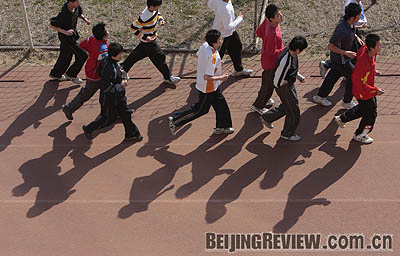|

ON THE RUN: Middle school students in Nanjing City jog on the school campus
In early October, the Ministry of Education, General Administration of Sport of China, and Chinese Communist Youth League jointly launched the nationwide "Hundreds of Millions of Students Sunshine Winter Long-Distance Running Program."
According to the official notice on the program, from October 26, 2008 to April 30, 2009, primary students in grades five and six should run a total of 120 km, junior middle school students 180 km and senior middle school students and university students 240 km. The reference daily distance is 1,000 meters for primary students in grades five and six, 1,500 meters for junior middle school students and 2,000 meters for students in higher grades.
On its website, the Ministry of Education explains the mission of the program, "the long-distance running program is held to strengthen the will, cultivate good physical exercise habit and improve the health of the youth."
The notice on the program also requires primary and middle schools to organize students into running units. During holidays, students should be asked to run voluntarily and keep records. Every unit of a school, grade and class should keep daily records, and compute the total distance that each student has run at the end of the program.
The notice also points out that its requirements are in principle, and that schools should exercise discretion on implementing the program. Individual students can adjust the daily distance according to his or her physical condition, as long as they can finish the required total distance within the six months. It should not be too difficult for students to meet the target.
Deteriorating fitness
Recently, the physical fitness of Chinese youths, especially of primary and middle school students, has been deteriorating and the issue has caused extensive public concern. In March 2008, Li Shundi, a member of the National Committee of the Chinese People's Political Consultative Conference, said that the Ministry of Education commissioned physical tests of primary and middle school students, and found that in the past two decades the physical fitness of primary and middle school students has declined. In particular, lung's capacity, speed and strength have continuously dropped for 20 years, while the percentage of overweight or nearsighted students rose rapidly. One factor attributed as a cause of falling fitness levels is the burden of schoolwork, which leave less time to exercise or sleep.
To address this situation, the government has issued a document on building the physical fitness of the youth, setting up specific measures to improve young people's health, such as reducing schoolwork, while increasing physical activity and sleep time. The long-distance running program is a measure to implement the government's idea.
Controversy
Public opinion reported in the press suggests that junior middle school students and their parents are generally accepting long-distance running, for it is tested during the entrance examination to senior high school. However, some parents of primary students and senior high school students find the policy unacceptable. A parent of one senior high school student spoke to the press and questioned the logic of making children run ever day when they are busy studying for the university entrance exam.
Many teachers believe that running will help to keep students fit, but have safety concerns.
"The physical condition of some primary and middle school students is so poor that they can hardly finish 1,000 meters. If accidents, such as sudden deaths happen, both the school and the teachers will be blamed," said a schoolmaster in Jiangan District, Wuhan City, in central China.
Currently, in some primary and middle schools in Beijing, students are prohibited from even playing basketball in their spare time in the absence of their headmaster. Half an hour after school finishes in the afternoon students are asked to leave campus and are not permitted to play sports on school property.
The People's Daily recently published an editorial on space shortages. Although some cities have luxurious fitness centers and well-lit plazas, little has been done to build school playgrounds. On the other hand, the number of students is rapidly growing, causing a decrease in per-capita sports resources. The editorial said, "More important than talking about whether students should run long distances, we should think about how to provide the necessary running facilities for them." | 